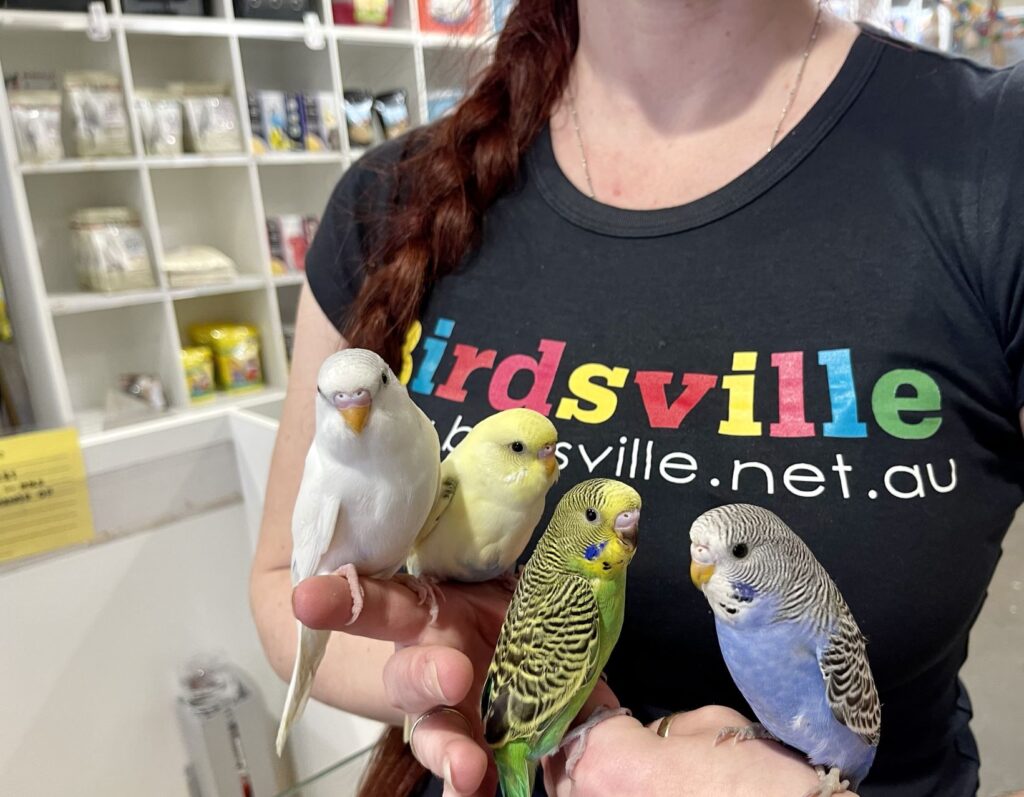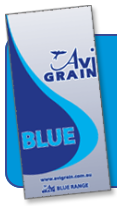Hand Raised Budgies for Sale Sydney
You will find out about hand raised budgies we stock and educate in all the important facts for responsible budgie ownership. Put it simply, a properly cared for, hand raised budgie will have a more resilient immune system, that is more capable of fighting disease and be a healthier animal.
Below we cover all the below topics and have links with important details all in this website:
- Bringing your budgie home
- Budgie training and steps
- Suitable enclosures
- Toys
- bathing
- Perching
- Diet supplements and nutrition
- Transportation
- Substrate
- Introducing your budgie to pets and family
- Medications
- Responsible pet ownership
- Nail trimming
- Hygiene
- Teaching to talk
- Budgie essentials list
- Extras you may not have thought of
- Enclosure set-up
- Wing trimming – pros and cons
- Health issues
- visual health check
- harnesses
- first aid
- Bird boarding
- and more.
Birdsville and our Breeder Recommendations
Everything listed on this page is exactly what we and our breeders recommend.
The knowledge we have accumulated is a combination of different avian experts working together. A combined knowledge of over a couple of hundred years, passed down from not only the original founders of the business, but influenced from the zoo industry, added input from many breeders and team members that work with us to improve the lives of birds and budgies in captivity as a whole.
Budgies are one of the most amazing little parrots in the world and the most popular for very good reason.
Our number 1 goal, for our customers’ pets, is to thrive physically and mentally. This is how we and our breeders keep our budgies happy and healthy.
Budgies are an amazing creature and with the right training they can do almost everything a large parrot can.
Budgies often live up to 10 years old and are very social birds.
Did you know?
Did you know we have a special bird and enclosure package deal with great discounts, if you are looking at owning one of these beautiful birds. We have a full range of everything you need to keep your budgie happy and healthy.
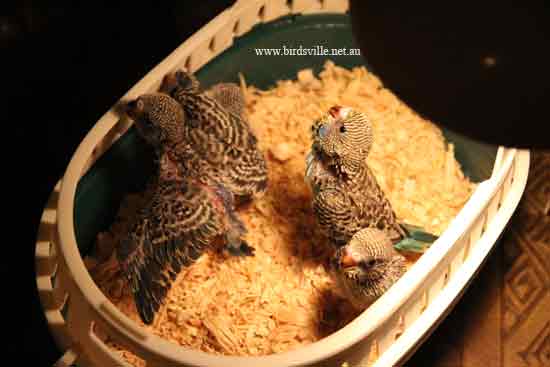
Check our Instagram or Facebook page to see our tips and updated photos of what hand raised baby budgies we have in stock.
https://www.facebook.com/BirdsvilleRosebery/
Bringing your new Budgie Home
For the first 48 hours
After setting the enclosure up for a newly arrived baby budgie, do not handle the bird for the first 48 hours. This gives them time to settle into the new environment and some of our baby budgies have never been in a enclosure before or away from other budgies.
For the first 4 days
It is very natural for a newly arrived baby budgie to be scared and stressed, due to the change in their environment. The stress may cause many baby budgies to not eat for the first day or 2. Regularly check if the seed is hulled (shell removed), is a good way to see if your budgie has been eating.
Offer extra millet sprays on the floor to encourage your baby budgie to eat. Millet sprays are great, because they are a fresh and recently harvested millet. Millet sprays are a little bit softer and excellent for encouraging your new budgie to crack and eat seed. When your budgie is eating properly and feels at home for at least 48 hours, then it is time to start training.
Start training by simply handling your hand raised budgie for short periods once to twice a day. This is important to create and strengthen your bond with the bird. Encourage your budgie to eat its favorite treats while you are handling them.
The first 10 days
Moving into a new environment is stressful for any budgie and this stress can easily make them susceptible to diarrhea and quickly leading to dehydration. This can reduce a budgie’s immune function and leaves them susceptible to illness.
When bringing your budgie home, we recommend all baby budgies have Aristopet Sulphadim in the water every day, for the first 10 days. This is important, because it reduces the chances of your new budgie from getting diarrhea, due to stress. This medication also reduces the chance of your budgie dehydrating.
As your budgie becomes more confident and gets use to its’ new environment, you can increase the amount of time you handle your budgie, as they bond to you. Once your budgie starts to become confident and handling is no longer stressful for them, they will love the attention and you.
On the 10th day of bringing your budgie home, your budgie is ready for worm treatment and lice and mite spray. Details below.
The first 2 weeks
If you have an existing budgie, other animals or birds, it is important to introduce them correctly. We always recommended to keep your new budgie quarantine for at least 2 weeks, in a separate enclosure from any other birds.
Introducing your new baby budgie to another budgie, by placing the enclosures at opposite ends of a large room, allowing them to see and hear one another. Introduced them slowly after the 2 weeks under supervision, watch to see how they are bonding and their behavior. Budgies are flock birds, and they usually mix with other budgies quite well, the gender of the bird doesn’t really matter.
Making sure to keep an eye on them and separate if either bird become aggressive or stressed and try again in another weeks’ time.
Introducing your budgie to a cat, dog, rabbit, guinea pig and other types of birds, will take time. Most pet animals will accept your new budgie being around and live harmoniously with them.
In the beginning, cats and dogs will show a lot of interested in your new budge, as predatory animals. Eventually they will get use to the budgie being a part of the family, but always have a close eye on your budgie when having out of cage time.
For more in depth details on this topic click on New Avian Introductions
Enclosure Set-up for a Baby Budgie
For the first 7 days, make sure there is an extra seed bowl and water bowl placed on the floor for easy access. It is still important to have food and water available in normal feeders on the side of the enclosure.
We recommend each enclosure should have at least 3 permanent feeders and one permanent drinker as minimum. One for quality seeds, one for pellets, one for water and spares for treats and veggies.
In the beginning, your baby budgie may only eat seed and Birdsville Budgie Blends. It can take some budgies a month or more to learn how to eat pellets, budgie crumble, mineral supplements and veggies properly.
In this learning phase, a constant supply of seed for your budgie is important or it may starve. Offering a varied diet will teach them to eat different foods. Supply an all you can eat buffet for the first 3 months!
* Important note: Seed sticks are a great chew toy, but a baby budgie will starve to death if they haven’t got proper seed and only supplied seed sticks or blocks.
Birdsville has many options available for dispensing water that are great ways to save you time and prevents your bird from defecating in the water. Budgies must always have a constant supply of fresh clean water.
Perches for a Hand Reared Budgerigar
Perches and the correct positioning of them in the enclosure are important. Some thought needs to go into making sure they not in a position that will hits the birds’ head or over food and water.
A minimum of 5 perches recommended, including at least 1 grit or concrete perch, 2 natural perches and the dowel two perches that usually come with a new enclosure.
Giving your budgie natural perches help stop a condition called bumblefoot. The natural grooves in the perch help distribute the pressure on their feet which helps stop this condition occurring.
BUDGIE TOYS
Creating environmental enrichment using toys will encourage your budgie to play and prevent aggression in the future. Toys should be provided from the start, as budgies love to play, but need to learn how.
A basic budgie set up will consist of a ladder, a swing per budgie and a minimum 4 to 6 appropriate toys for chewing, preening and playing.
To get the best usage of space, think of the enclosure as 3 levels. You want to utilize all levels of your enclosure, the top, middle and bottom (floor) with toys.
* For example: hanging chew toys and natural toys at the top, bell and forage toys for the middle and foot toys (bar bell or balls) on the bottom.
Do not use the same toys, a variety makes it much more interesting and entertaining for your budgie. At Birdsville we have Australia’s largest range of bird toys.
Swings and ladder provide exercise as the bird has to use muscles in a different way, than it would on a still perch.
The happier and the more mental stimulation your bird get, the tamer and healthier they will become as a pet.
The goal is to keep your budgie entertained, while you are away, and they are in their enclosure. It also helps prevent behavioral issue down the track, such as plucking, noise level, aggression and general bad behavior. Toys help creates a tamer, friendlier and happier budgie in the long run.
Rotated your toys regularly, so preventing your budgie from getting bored. Destroying their toys means your budgie loves it and it needs replacing. Watch for wear and tear and discard when they become damage or rusty.
We have different toys arriving at Birdsville all the time.

ENCLOSURE AND CAGES FOR BUDGIES

Remember a bird’s enclosure should be an area they love to be in. Many of our customers have birds that put themselves to bed, after they have out of enclosure time.
Budget, personal taste and location play a large role in selecting an enclosure for your budgie. Selected the largest enclosure possible to ensure your budgie has adequate area to move around once you add perches, food/water bowl and toys. The bigger the enclosure, the better it is for your budgie and the less cleaning there will be.
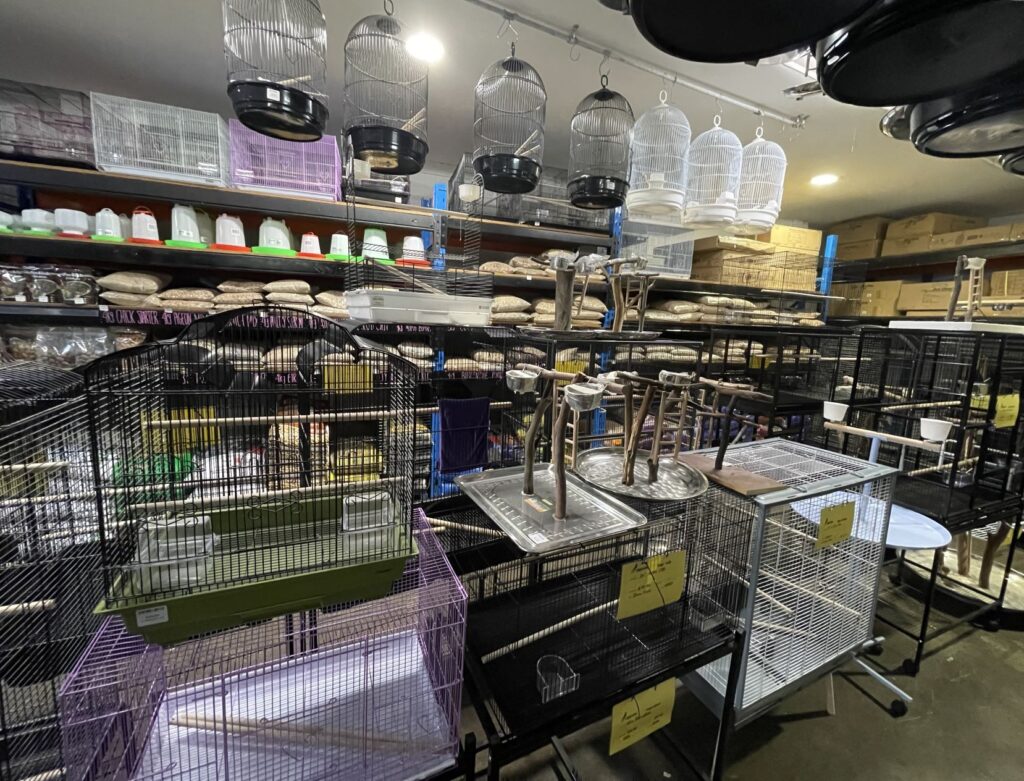
An enclosure with a large front door is not essential, but I think important for when you are taming your budgie. It makes it easier to get the bird in and out when it is on your hand and aids in teaching your bird to step up.
Visit Birdsville and have a look at all the different enclosures and styles, as there is many different shapes and sizes. Some cages are unsuitable for budgies, if you’re unsure ask one of our team. Never choose a round cage for a budgie.
When chatting to one of our team ask them about our package deal discounts.
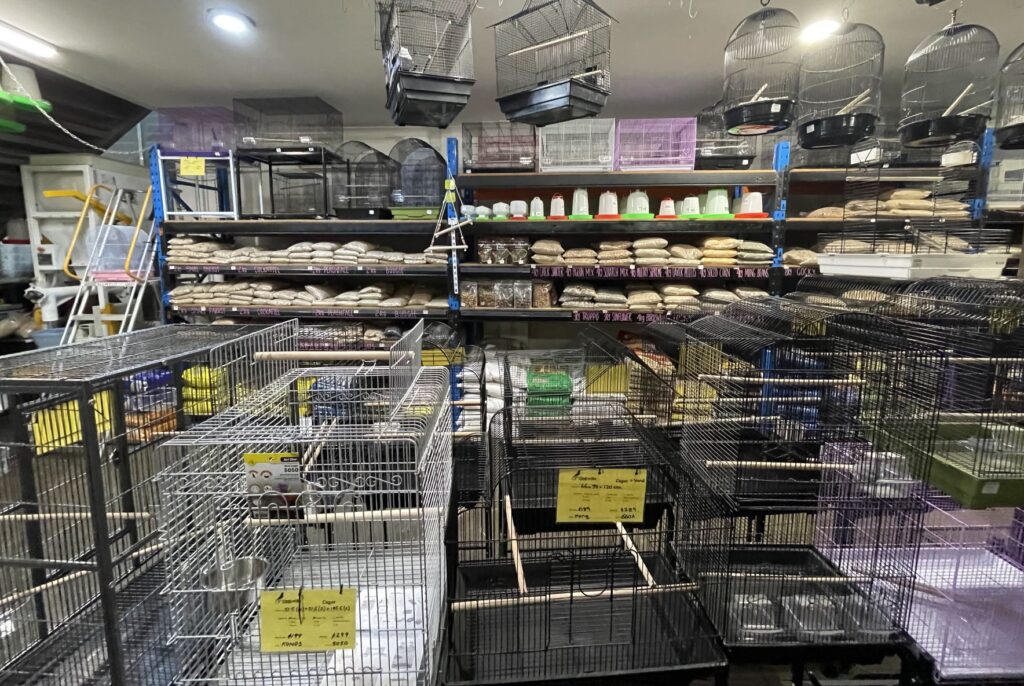
Diet for Hand Raised Budgies
The bulk of a budgies diet is seed mix. Sadly, I encounter people all too often who only supply their bird with seed and water, which isn’t quite adequate for any bird. Made worse when it’s a low-grade seed mix.
It’s essential for the first 7 day, newly arrived baby budgies to have additional high-quality seed and water bowls on the floor, until they learn to use the normal bowls. As mentioned below.
We recommend a ratio of approx. 25% – high-quality pellets or crumble, 65% – high quality seed or seed blends and 10% – fruit, veg and greens. Birdsville blends also contain vegetables and greens that will add to this base diet.
Offer baby budgies an all you can eat buffet for the first 3 months.
Birdsville only stock high-quality seed mixes and specialty mixes with added greens, fruits, veg and legumes. All our healthy seed mixes, have been developed, made and bagged by our team, fresh on-site, making them great value for our customers.
After about 3 months you can begin to feed your bird a higher quantity of pellets.
We choose to have separate bowls for pellets and seed blends, allowing you to know exactly what they are eating. It’s not wrong to mix them in the same bowl, it is just what works for you.
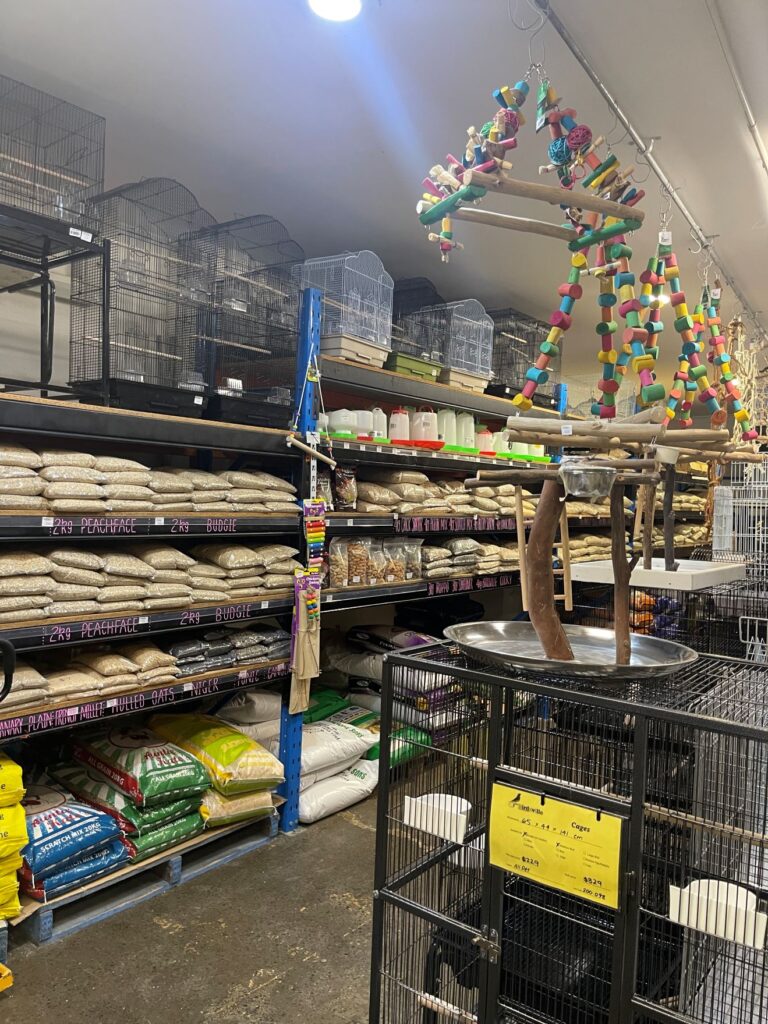
Budgie Seed
High-quality seed mixes are the only way to go when choosing a seed mix for your budgie. Many seed mixes that can be found in supermarket and chain store come in a pretty packaged box, doesn’t mean it is high quality.
Low-quality seed often contains a lot of filler, adding colored bits, large un-edible seeds like sorghum, dusty, excess rape seed and shell grit added for weight. Shell grit is important, but it is better if supplied separately.
A high-quality seed really makes a big difference to your bird’s health. We have always said place a high-quality seed and a low-quality seed in 2 different dishes beside one another and watch which one the bird will eat.
If you are not sure about the seed you are using, take it into any bird specialist store and they will be able identify and explain the seed mixes.
Bird specialist stores will always carry high-quality seed, because breeders depend on it, to get their prized birds to breed healthy offspring.
To keep your seed fresh, it is advisable to buy the right quantity for the number of birds you have. Seed and grains can lose its nutritional content over time.
If you have one budgie, you are better off buying small amounts of seed at regular intervals. A 2kg or 4kg bag is the best value for money for one or two birds.
For overweight budgies increasing the French White Millet percentage to their diet will help reduce the weight. Our Birdsville team has this separate in store.
Do not feed budgie’s
Lettuce, cereal, avocado, onion, garlic, sugar, corn, beans, breads, sweets, chocolate, biscuits, coffee and some garden plants can be toxic.
Birdsville Budgie blend
A beautiful addition to add to your budgies diet that has mixed herbs, beetroot, vegies and plenty of other goodies.

Pellets
Pellet adds additional vitamins and minerals that your budgie can’t get from seed alone.
Changing your budgie diet completely to pellets, may result in your budgie actually starving, especially if the budgie is a baby. Slowly introduce pellets, so your budgie can learn what it is and how to eat it. At Birdsville, we prefer to give budgies pellets, as a supplement to their diet. It can take months to wean a budgie onto pellets.
We stock vetafarm budgie crumble, Passwell budgie starter and mini pellets for our budgies we have not found a better pellet for this species of bird.

Millet spraysfor budgies
Budgies love millet sprays and its good for them. This is a very fresh millet seed, which encourages baby budgies to eat more, and adult budgies just enjoy them.
There are many different millets to choose from, although I find French White to be the healthiest option for your budgie.
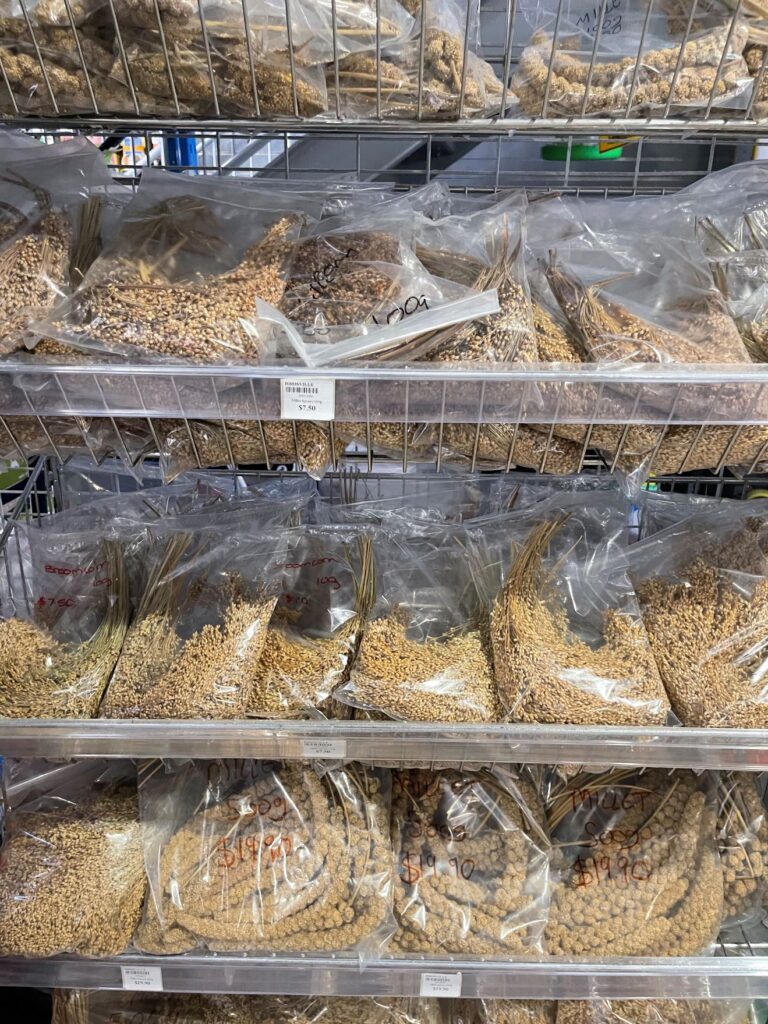
The good oil
The good oil is packed with liquid Omega 3 and 6 supplement. It can improve the overall health of your budgies and their eggs. It can also, assists with fatty liver disease in older birds.
Omega 3 and 6 can be deficient in many grains and this can help repair the liver, egg production and immunity. The good oil also contains fat – soluble vitamins including A, D3 and E. Easy to use mix 15ml of the good oil per kg of seed. Let the mix stand for at least 4 hours at room temperature before feeding to ensure the oil leaks into the kernel of the seed.
Greens
Supply your budgie with some vegetables such as broccoli, spinach carrot, beetroot, snow peas, green beans and celery. Budgies are natural green veggie eaters, so they may not take to fruit, but can still be tried.
They also love pieces of unsprayed fresh grass.
Sprouted Seed
All budgies love sprouted budgie seed.
The germination process unlocks extra nutrients making it easy for your budgie to absorbed. Imported seed get irradiated on arrival to Australia, meaning only high-quality Australian seed can be sprouted.
There can be a risk of disease, if sprouted seed is prepared incorrectly. To prevent this the using Passwell Multi-clens or Vetafram Aviclens is recommend.
For instruction on how to sprout seed, please click the Link for sprouting seed.
Birdsville always has a variety of mixes that can be sprouted available.
Iodine
Important for all birds, as they can develop issues with their thyroid gland. Budgies are especially known to be often deficient in iodine, so make sure you supply them with iodine bells, perches, or buttons.
Calcium
For overall health and vitality of your bird, as they have hollow bones unlike mammals, so they cannot store minerals and calcium. They need a lot of calcium to support egg production, beak, nails, feathers and other bodily functions. So, both male and females need calcium.
Providing calcium in the form of a calcium perch, bells, buttons and cuttlebone are essential for budgies. One of these items, only need to be present inside your budgies’ enclosure and the bird will sample them when needed.
Vitamin D
Vitamin D can only be obtained by direct sunlight. It is an important vitamin for aiding the in the absorption of calcium.
Indoor budgies usually have a calcium deficient, as vitamin D is filter through a window, leaving your budgie with the inability to absorb calcium. If your budgie is getting filtered sunlight, then there is Vitamin D supplements can be added to the water.
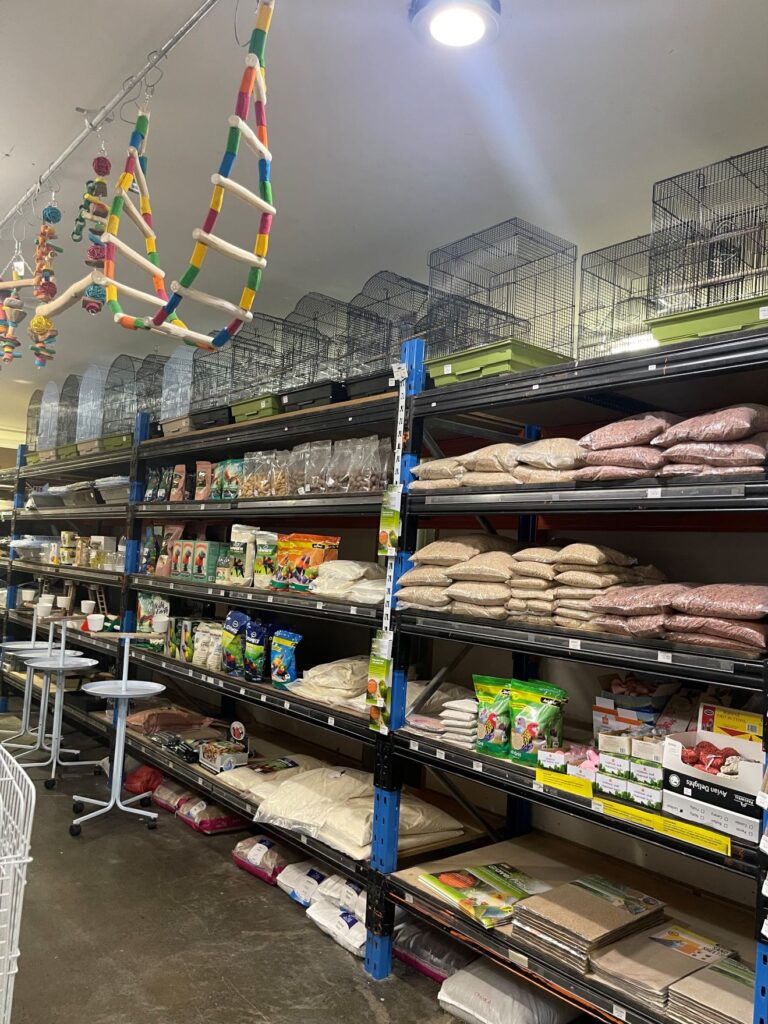
Interestingly, when we do a nail clipping for customers we can actually tell if your bird has a calcium problem or vitamin D deficiency. Budgies lacking in calcium, get a whole list of health issues and a shortened lifespan.
Many customers with budgies that have a calcium problem say, “oh, but my budgie gets lots of sun. My budgie lives next to the window and the sun shines on them every day”.

Unfortunately, glass filters the sun, and you can’t get vitamin D through glass. Birds need around 10 hours a week of unfiltered sunlight to get the right amount of vitamin D.
Listed below are links to avian vitamin D supplements we stock in store – Vetafarm Soluvite D – Vetafarm D Nutrical and Vetafarm Calcivet Liquid.
If you are unsure which to use, visit our team instore and we will be able to help you.
Outside budgies use Multivet and inside budgies use Calcivet, Ornithon or Soluvite D. Adding vitamins to your budgies water is very important for the health and vitality, as pets’ budgies cannot get all require vitamins from diet alone.
Another popular indoor method of giving your bird Vitamin D and the added benefit of receiving UVA and UVB lighting we stock avian sun globes to bring the sun to an indoor environment.
Vitamin supplement
To add many essential vitamins that a captive environment does not provide. There are many great bird vitamin supplements available in Australia, popular vitamins, include:
Water
Budgies need access to clean drinking water at all times. A bird or rodent drink bottle does create easy maintenance, as its difficult for birds to sit above them and dirty their water, like they could with an open container. We recommend adding multi-clens to your birds water to help maintain a clean, healthy water supply.
Bathing
It’s important to offer at least once a week a little bird bath for your bird to wash themself. Offering regular areas to bath from a young age will make sure your budgies won’t lose that ability to bath. This will result in a bird that is less healthy and a bird with poor feather quality.
Substrate for the bottom of the budgie Enclosure
We recommend grit for the bottom of your budgie’s enclosure, as it heavy and doesn’t blow around when the budgie flaps theirs wings. It is also great for budgies to forage in, its edible and a source of calcium. It is makes it very easy to spot clean your enclosure.
We use grit in our bird enclosures at Birdsville, if you would like to see what it looks like.
Substrate only needs to be about one inch deep. There is other substrate that can be using including, grit sheet, silver sand, paper litter, saw dust, ect, all of which is available in store.
Avian Cage cleaner for Budgies
Household cleaners and detergents can be toxic to budgies. Non-toxic avian cage cleaners can be found in-store, getting used by our team during cleaning, and is always available.
Avian cage cleaner makes cleaning your enclosures very easy as the poo comes off much more easily and disinfects at the same time. Avian cage cleaners have been designed to keep enclosures clean and safe. They are non-toxic to budgies and easy to use. They remove dirt and debris easy, as well as gently deodorizes without strong fragrance that could upset your bird.
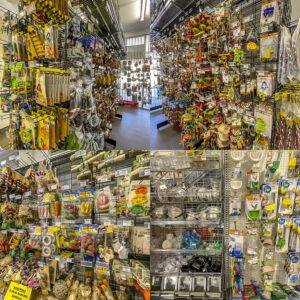
As bird specialists we have the biggest range of bird products in Australia
Sulphadim or sulpha 3
Liquid Magic for newly arrived baby birds. When moving baby birds into a new environment, we recommend suppling Sulphadim or Sulpha 3 into thier water for 10 days consecutive days.
Anytime your budgie (new, young or old) is moved or transported, it is recommended adding Sulphadim or Sulpha 3 to the water.
Movement for any bird cab cause stress and potentially give them diarrhea. Sulphadim or sulfa 3 is a mild antibiotic that helps calms them down, reduces the chances diarrhea and de-hydration.
When a Budgie gets stressed, they become dehydrated and can be susceptible to illness. The main reason is it compromises their immune function and leaves them open to pathogen that wouldn’t normally affect a bird with a healthy immune function.
Sulphadim can be used 2 different ways, we are using it for diarrhea prevention which is 8 drops per 100 ml. Or you can mix up a liter’s worth which is 75 drops to a liter. This mixture is to go in your newly arrived birds water supply for the first 10 days. Making sure containers are either plastic or ceramic and not metal.
After the initial 10 days, do not throw out this product. It is very useful incase at a later date if your bird develops diarrhea or you may moving/transporting your bird.
This medication is also used for the treatment of common avian bacterial infections, including pneumonia, caecal coccidiosis, white scours and enteritis.
To treat for this, add (0.67ml) per 30ml of drinking water.
WORMING YOUR BUGDIE
Worming budgies too young can upset a baby budgie’s crop (stomach), causing them to stop eating, as they have only just learnt how to eat on their own.
Young birds that have recently weaned have delicate bacteria’s developing and a sensitive crop. Worming to early, when young or after moving to a new location is an added stress to your newly arrived bird.
After waiting 10 days for your budgie to settle in, they will be at the right age to be wormed, if you purchased a recently weaned baby budgie.
Indoor budgies should be wormed every 3 months and outside budgies every 6 weeks. We recommend worming any new bird, whether it has been previously wormed or not, as a safety precaution.
Common house flies are known to spread a large number of parasitic worms. The fly would pick up the worms from wild bird/rat feces, fly inside, landing on your birds’ water, food bowl or on your budgie and infects them.
Humans and other pets can get and spread the same worms. Worms can kill your budgie, so it’s important to get them wormed. Not only to protect them, but also the whole family and other pets.
Application
Application is very easy, simply follow instructions on the packet and add solution to water.
Worming your new pets while they are quarantined will help stop the spread of worms to your existing pets, children and family.
Lists of wormers available at Birdsville:
Worming your bird is actually very easy, it simply goes in the water supply. Check the label on the bottle for the amount.
The medicated water needs to be the sole source of drinking water for 24 hours. Repeat treatment after 14 days. The worming process is repeated 4 times a year for inside birds and outside birds every 6 weeks.
Why are worms bad for your bird and you?
Worms cause a range of diseases, the severity of which depends on the species of worm they are infected with. Parasitic worms have an indirect lifecycle with many insects such as fly’s, beetles, cockroaches, other insects and feces acting as intermediate hosts.
Worms can weaken your bird’s immune system which inadvertently can kill your bird from a virus that a bird with a strong immune system can fight off.
Worming a bird after a long period can cause intestinal or respiratory blockage from the dead worms in adult birds. It may be a good idea to worm them with a half dose first.
Some worms multiply slowly and some quickly depending on the kind of worms.
Worms that can infect birds, include:
- Tapeworm Worm (Choanotaena spp, Raillietina spp)
- Thread Worm (Capillaria spp.)
- Roundworm (Ascaridia spp.)
- Ceacal Worm (Heterakis gallinarum)
- Hook Worm (Acuaria spp.)
Lice and mite spray for your hand raised budgie
Two of the most common parasites pet budgies and their environment is lice and mites. They can be easily controlled with a Mite and Lice spray, available at Birdsville.
When using, remove all feed and water to entire enclosure, perches, nesting box, toys and birds (try to avoid spraying in birds’ eyes).
Indoor budgies should be sprayed every 3 months and outdoor every 6 weeks.
Lice and mites can unfortunately spread everywhere and budgies in an inside environment are still susceptible.
Lice & Mite Spray is recommended to apply the same time you worm your budgie, making it easier to remember doing it together. Apply lice and mite spray 10 days after bringing home a new arrival to align your medication routine of worming.
Application
Application is very easy, simply follow instructions on the packet and spray budgies’ body, back and under wings while avoid the eyes. This medication will not damage the eyes if you make a mistake, but it will be unpleasant experience for the bird.
If you’re unsure of which one to buy, visit us in-store. We can check your bird over and recommend one of the following:
Why is lice and mites bad?
Aside from irritating It can eventually kill your bird in severe cases. Mites and lice are a stress to your bird through sucking its blood and making your bird anemic. Lice and mites can cause plucking and skin conditions due to itchiness. These things can weaken the immune system and make your bird susceptible to disease that your bird would normally fight off.
Lice and mites are most commonly spread by common insects such as cockroaches and fly’s this is why inside birds should still be routinely sprayed.
Trimming your budgies’ nails.
There are many perches available at Birdsville, such as sand, concrete and grit perches that are excellent to help ware down the tip of your budgies’ nails.
However, some budgies need them trimmed and this can be done in store.
Budgies usually need a nail trim at least twice a year, if they are not being worn down by perches. Our Birdsville team can assess the health of your bird during a nail trim and even show you how to do a visual health check.
No need to book an appointment, we can check your budgies’ nails anytime we are open.
Training your hand raised budgie.
Handle your budgie for 15 minutes, no more than 3 times a day gently for the first couple of days.
Handling of hand raised budgies is important to create and strengthen your bond with your bird.
* Tip – if your budgie is spooked and runs away, gently pick up and continue calmly handling your budgie with 2 hands and bring them close to you, before teaching them to step up. Repeat this process until your budgie relaxes.
A hand raised budgies are tame but not trained.
* Remember – that your baby budgie needs to adjust to the new environment, so be calm, patient, handle your budgie and your budgie will bond with you.
Many new budgie owners who are new to birds, can be scared when they flap their wings. Budgies are very perceptive creatures; this fear can set back you’re training and bonding. It is very important to not be scared of your bird and be a calm leader.
Basic Training
Basic training has huge benefits for you and your budgie. It requires dedication in the first few weeks, repetition and persistence is the key. If your budgie bites you, do not pull away. Wear wool gloves, if you need to and continue to gently handle it. When your budgie isn’t nibbling your gloves, then take them off.
The early days are the most important time to bond with your budgie. When you are watching TV or reading is the best time to tame your budgie as you are relaxed, just let your feathered buddy to hang out with you and they will very quickly bond with you as they get used to you.
Budgie Training is an important factor of having a well-behaved hand raised budgie. When you first get the bird home, let it settle down and get use to their new environment for a day or two. Make sure to not over stress your bird in the first few weeks of taking it home, babies need their rest. Remembering more time within reason you spend with your bird, the better your bird will become.
Like all birds when you give your budgie time to bond with you it will get tamer and tamer. If your budgie is in a group with other birds, it will display more bird like behavior but when you take your budgie home and train them, and they start bonding with you it does not take long before they become very tame. As long as you put the work in early.
click the link for detailed bird training.
Bonding with your Budgie
Getting one budgie will bond with you a lot easier than 2 or more. Yes, you can take more than one budgie at a time, but you will need to spend a lot more time training and taming them. If you want more than one budgie it may be better to get one at first and when the first budgie is super friendly, then get the second budgie when the first one has been super tame for at least 3 weeks. This has a benefit as budgies learn from each other and it will be even easier to tame the second budgie.
Once the bird has reached a certain age of at least 8 months of age it will generally always be tame and bonded to humans.
Common training Mistakes
The most common mistake with training is the new budgie owner chases the bird around the cage before they handle the bird, or the bird runs away from them, and they are too afraid to handle it.
There is nothing wrong with the budgie, but the human may need a bit of coaching. So please keep reading this paragraph, if you chase a budgie it will learn to fear, you. If you don’t handle the bird, it won’t get a chance to bond with you. Try to quickly catch your budgie with 2 hands not one until your budgie is trained to step up.
If a bird is jumpy make sure you handle the bird on a couch or a bed until they settle down, this can save the bird as repeated falls can rattle the birds’ organs and easily kill a budgie. Birds including budgies do not have a diaphragm, so their organs kind of hang in their cavity and are more susceptible to damage than a small rodent of the same size.
Ignore bad behavior and reward good behavior. If your budgie runs away, gently pick up and continue calmly handling. If you allow your budgie to run away and not be handled, it will not form a bond.
The budgie being handled close to you, will create a bond and your budgie will get used to you.
Keep an eye on children, they can over handle a small budgie to death all too easily. Many children do not understand how to train a bird and they will need supervision.
Click for more details on training
first steps in training your baby hand raised budgie.
- After handling your budgie get them to stand on your finger
- Get your budgie to step up from one finger to another by placing your free finger Infront of the budgie and slightly pushing on the chest. This will encourage the budgie to step up. Repeat process until budgie understands and steps up.
- Once your budgie is stepping up on your fingers then train them to step up from your finger onto a perch and reverse.
Teaching your hand reared budgie to talk
As budgies hold the world record in the most words said by any bird, they can be great talkers. Some budgies simply won’t talk, and some will. This is a lucky dip, but to increase the chance of your bird telling you need to repeat words to them over and over again. Some people cheat and played recordings to their bird, and this has worked quite well.
Click for more details on training
Sexing Budgies
You can usually tell the sex of your budgie by the color of the ‘cere’ (nostrils). The hen will have a brown cere and the males will be blue. In some mutations such as yellow, pied or white budgies it can be more difficult to determine their sex as the cere stays pink on the male. When sexing baby budgies, the young hen will usually have an opaque cere, whilst the males will be a light pink-ish color.
Baby budgies can be easily identified, as they have a darker colored eye and the feathering on the top of their head has a series of bars that continue down to the cere.
The cere is the fleshy part above the beak that holds the nostrils (nares). Baby boy budgies will have a cere that is colored pink or purplish in color, that turns blue in adulthood. Baby girl budgies will have a cere that is a whitish brownish even opaque colored, that turns brown in adulthood.
Sexing cannot be 100% or guaranteed for baby budgies, but you can be quite accurate by comparing budgies to increase your odds of getting the desired sex.
Males and females can make wonderful pets.
A baby budgie will start to molt the bars on top of the head to reveal a clear color when they reach 3 months old.
Wing trimming a hand raised budgie.
There are pros and cons to both sides and having your budgies’ wings trimmed will not ensure it can’t fly away. Done correctly, it can reduce flight, allowing them to glide safely to the ground.
Some owners allow their budgies’ wings to grow out. This is great too as the budgie gets plenty of exercise. There is also a greater risk of losing your budgie if you forget to close a window.
If you choose to have your budgie fully flighted, make sure all windows and doors are closed while your budgie is out. It is also a good idea to harness train your budgie for outings.
Birdsville have a range of harnesses available.
I personally prefer my birds flighted. When they were learning I placed tape on all my windows to help them avoid flying into glass. All bodies of water need to be removed, as a bird could fly into a toilet, cup, bowl, saucepan, fish tank or any difficult to get out of.
Is a wing trim painful for a budgie?
Budgies’ feathers are made out of keratin, the same as our hair. When a wing trim is done correctly, it’s about as painful as getting a haircut.
Our budgie experts know how to trim a budgies’ wings with as little stress as possible on your budgie.
Most budgies go through a molt at least twice a year and re-grow their flight feathers. If you have a budgie with trimmed wings, keep an eye out for when they molt, and flight feather start to grow back. They go from 0 to 100 very fast.
We do wing trims in store, no need to make an appointment. We do walk ins any day of the week.
Our Baby Hand Raised budgies
Our baby hand raised birds all come with their flight feathers trimmed for a number of reasons. When they are hand raised, they are all done, flighted and a wing trim is preformed about a week prior to arriving at Birdsville.
This is because we have the public coming and going, deliveries and different doors always opening and closing in store. As you can imagine, birds fly very quickly and can fly straight out the door unclipped. Also, customers looking at adding one of our birds to their family, will want to handle our hand reared birds. If they are flighted this simply wouldn’t be possible, as they can simply fly off and could possibly fly into a window, wall or even outside.
A baby budgie with trimmed wings on average takes about 4 to 6 months to grow back.
Click for more details on wing trimming

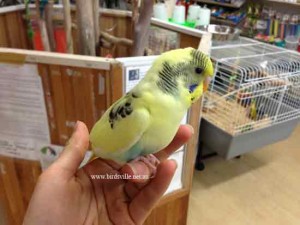
Budgerigar Essentials list
Carry Enclosure
Every budgie owner needs one for safe transport, also useful for birdy adventures or to hold during enclosure cleans.
Quality Seed
Avoid low-grade chain store or supermarket budgie mixes with filler, as it may decrease your budgie’s health/survival rate. Our Birdsville Budgie mix has no filler, not only keeping your budgie healthy, but saving you money.
If you are not sure, place our quality seed mix in one container and place the generic mix in the other and watch what the bird will do. They taste the freshness and the quality and will always eat the better-quality grain.
Birdsville blend
A high-grade blend of grains with herbs, beetroot, Niger seed, sunflower kernels and plenty of other goodies. This can be fed as a normal seed replacement, but to get the best value we recommend mixing this blend with your quality seed mentioned above.
Pellets
Vetafarm Budgie Crumble, Peckish, Passwell Budge Starter, we only stock the best!
Millet Sprays and seed Bar
Millet sprays are great for training & getting young budgie eating, while transitioning to their new environment. A seed bar is a forage toy, very good and getting your bird to forage and chew.
Healthy Treats
Birdsville Gourmet Budgie Blend with added fruits, greens, beetroot, veg and legumes is arguably the healthiest mix you can get your budgie.
Enclosure
Please consult staff on enclosure recommendation, all too often we meet people who purchase the wrong enclosure.
Toys
1 Ladder, 1 swing per budgie in their enclosure, with a minimum 4 appropriate toys for chewing, preening, and playing.
Perches
Minimum of 5 perches, including at least 1 grit or concrete perch and 2 natural perches and two perches usually come with a new enclosure, making 5 perches in total.
Substrate
Grit or sand sheets, great for birds to forage in and makes it very easy to spot clean your enclosure. View substrate in our aviary budgie enclosure.
Calcium / Iodine
Calcium and iodine supplements is essential for birds and come in the form of perches, bells, buttons and cuttlebone. Pink ones contain iodine, white ones are for calcium and perches contain both.
Vitamins
Outside birds use Multivet and inside birds use Calcivet, Ornithon or Soluvite D. Very important for their health, as budgies cannot absorb vitamin D through glass, they need direct sunlight.
Wormer
Worm your budgie 10 days after bringing it home. Simple to use, just follow the directions on the bottle.
Lice & Mite Spray
Lice & Mite spray is recommended 10 days after purchase. Simple to use, point and spray avoid birds’ eyes – directions also on the bottle.
Sulphadim or Spark
Helps prevent stress from transition, which may lead to them getting diarrhea and reduces dehydration. Mix in drinking water for 10 days upon bringing your budgie home. Simple directions on bottle.
Cage Cleaner
Vetafarm Avicare, F10 or Arisopet are all bird safe, nontoxic disinfectant and makes it easy to remove poo and dirt from enclosure, toys, perches, and bowl.
Normal disinfects can be quite toxic to budgies.
What you may like to consider
Enclosure stand
Some large enclosures already come with a stand and all enclosure suitable for a budgie can have a stand available. These are great to lift the enclosure off the ground, to an easy level to interact with your pet.
Enclosure Cover
Covering your budgies enclosure is a personal decision, some people like to cover their bird of a night, this can decrease early wake ups.
Enclosure Tidy
These are great for reducing mess but won’t eliminate completely. They wrap around the enclosure at the base and help to bounce bits of seed and grit back into the enclosure kind of like a boob tube for a enclosure.
Spare bowls (food & water)
Swap bowls, if normal one gets dirty and need a soak (easy cleaning) or to add an addition food.
Additional bowls are also recommended in the first 7 days of bringing your new bird home.
No Mess Feeder
These reduce mess and prevent your budgie from spreading food everywhere.
Worth its weight in gold and gives you more time to love your budgie.
Drink Bottle
They can’t poo in them, reducing the amount of time you have to change the water and less mess.
A drink bottle can reduce the chances of your budgie be left without water on a hot day, due to them bathing in it.
Cuttlebone, Fruit & Millet Spray Holders
An additional way of suppling cuttlebones, fruit and millet that can make them more interacted for your budgie and keep them off the ground and reduce waste.
Bird baths
Bathing is important for birds’ wellbeing. You can use large, shallow feeders, bird shampoo, spray bottle and shower perches.
Improves feather and skin condition
Tents and Hides
Tents, pouches, hammocks, and hides. You will be surprised how much some budgies love these.
Bird Stand and Play Gym
Excellent for budgie training, as well as giving them a place to hang out and play. Additional toys can be added to create environmental enrichment.
Synbiotic / Probiotic
Can boost immune system, support digestive function when use daily.
First aid
- Vetafarm Spark
- Aristopet Sulphadim
- Vetafarm Triple C,
- F10 barrier ointment
- heat lights
- The Good Oil – great for improving liver function in your budgie and overall health.
Harnesses
Harness provides an added safety when outside with your budgie. Harness training does take time and should never expect your bird to expect it straight away.
- Tips – in store check our reptile and small animal sections upstairs. There are some great products for bathing, hides, cool bowls, toy and so on.
Health Issues in Budgies
If you ever notice a change in behavior and/or appearances, such as:
- your budgie sitting on the floor of the cage fluffed up
- swelling around the eyes
- feces covered vent
- down spirited
We suggest, as a first line of defense adding antibiotics to your budgie’s water supply and a heat lamp. Sick birds almost always stop producing enough body heat and are unable to warm them self effectively.
The reason many sick birds fluff their feathers up, is to conserve and trap in body heat. It’s VERY important that a heat lamp is provided. A blanket over the cage or placed next to a sunny window will not do the trick even on a warn sunny day.
The use of antibiotics without a heat lamp, can render the antibiotics almost useless. A broad-spectrum antibiotic and heat lamp will often fix most of the common budgie ailments. If your budgie doesn’t appear to be improving, you need to see a vet.
We have a list of vets at the bottom of this page.
Birdsville have a large range of heat globes and ceramic attachments they do not cost much and can likely save your birds life. We stock broad-spectrum antibiotics. Broad-spectrum antibiotic is an easy-to-use powder, simply adds to your budgies’ food or water.
Visual Health Check
If you are not sure how to tell what a healthy budgie looks like or how to perform a visual health check, we will happily show you. Our team performs and show our customers how to perform a visual health check with every animal sold.
Please bring your in budgie in-store to Birdsville, we do not charge to do this. If you have purchased your budgie from somewhere else, we are here to help. A skill set like these are great for any budgie owner to have and allows you can have a much better ability in spotting if your budgie is not 100%.
Poor nutrition or incorrect environment or stress can mean the difference to your bird being healthy, having a strong immune system and being more disease resistant.
Every new bird owner must read through our Common Bird Illness to familiarise themselves with common issues. We have taken the hard work for you and summarised almost every possible common issue.
See, Common Health Issues page. Click this link
Please follow the link above, for important summarised info on:
- diet and mineral issues
- environmental risks
- potential poison
- bird stresses
- temperature stress
- moisture issues
- hygiene
- diseases
- baby birds and unweaning
- contamination risks
- parasite
- injuries
- and more
Budgie Bird Boarding
Click link above, we can board your budgie, if you go away on holidays. Boarding is available throughout the year, please visit petsvillehotel.com to check it out and book your budgie in.
Don’t hesitate to come and see us in store if you have any concerns, or questions and bring your budgie for us to see.
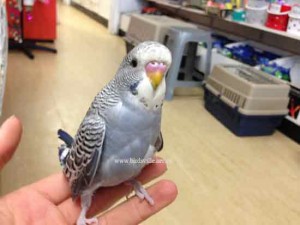
Are you ready to be a Budgie Guardian?
Recommended Birdsville Vets in Australia click on this link and scroll down to the bottom. Common Bird Illness
The Wild Vet
1300 9453 83822A Bridge Road, Glebe Carlingford
Animal Hospital
02 9871 6036
772 Pennant Hills Road Carlingford
SASH
Small Animal Specialist
Hospital 02 (9190 6806)
Level 1, 1 Richardson place North Ryde
02 9436 4884
57-63 Herbert St Artarmon
995 Bourke Street waterloo Sydney NSW 2017
